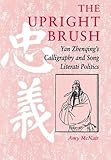The Upright Brush : Yan Zhenqing's Calligraphy and Song Literati Politics / Amy McNair.
Material type: TextPublisher: Honolulu : University of Hawaii Press, [1998]Copyright date: ©1998Description: 1 online resource (200 p.)Content type:
TextPublisher: Honolulu : University of Hawaii Press, [1998]Copyright date: ©1998Description: 1 online resource (200 p.)Content type: - 9780824865146
- 745.6/19951/092 21
- NK3634.Y45 M39 1998eb
- online - DeGruyter
| Item type | Current library | Call number | URL | Status | Notes | Barcode | |
|---|---|---|---|---|---|---|---|
 eBook
eBook
|
Biblioteca "Angelicum" Pont. Univ. S.Tommaso d'Aquino Nuvola online | online - DeGruyter (Browse shelf(Opens below)) | Online access | Not for loan (Accesso limitato) | Accesso per gli utenti autorizzati / Access for authorized users | (dgr)9780824865146 |
Browsing Biblioteca "Angelicum" Pont. Univ. S.Tommaso d'Aquino shelves, Shelving location: Nuvola online Close shelf browser (Hides shelf browser)

|

|

|

|

|

|

|
||
| online - DeGruyter The Thread of Life : Toraja Reflections on the Life Cycle / | online - DeGruyter The Three Boys : and Other Buddhist Folktales from Tibet / | online - DeGruyter The Typhoon of War : Micronesian Experiences of the Pacific War / | online - DeGruyter The Upright Brush : Yan Zhenqing's Calligraphy and Song Literati Politics / | online - DeGruyter The Victim as Hero : Ideologies of Peace and National Identity in Postwar Japan / | online - DeGruyter The Voyage of Contemporary Japanese Theatre. | online - DeGruyter The White Pacific : U.S. Imperialism and Black Slavery in the South Seas after the Civil War / |
Frontmatter -- Contents -- List of Figures -- Acknowledgments -- Introduction -- 1. The Politics of Calligraphy -- 2. Yan Zhenqing’s Illustrious Background and Early Career -- 3. “The Nest Tipped and the Eggs Overturned”: The An 3. Lushan Rebellion -- 4. Partisan Politics at the Postrebellion Court -- 5. From Daoist Inscriptions to Daoist Immortal -- 6. Buddhist Companions and Commemoration -- 7. The Late Style of Yan Zhenqing -- 8. Confucian Martyrdom -- Notes -- Glossary -- Bibliography -- Index -- About the Author
restricted access online access with authorization star
http://purl.org/coar/access_right/c_16ec
In the history of Chinese calligraphy, few are more famous than the eighth-century statesman Yan Zhenqing (709-785). His style is still taught today as a standard, and Chinese bookstores the world over stock inexpensive reproductions of his works for sale as copybooks. Yet Yan's style cannot be called conventionally attractive. "Correct," "severe," "serious," "forceful" are terms habitually applied to describe his writing--rarely has his calligraphy been called graceful or beautiful. How, then, did Yan earn such an eminent place in the history of art? In The Upright Brush, Amy McNair argues for the political rather than purely aesthetic basis for Yan Zhenqing's artistic reputation. She shows how his prominent position was made for him in the eleventh century by a handful of influential men who sought to advance their own position by associating themselves with Yan's reputation for uprightness. Equating style with personality, they adopted Yan's calligraphic style as a way to clothe themselves in his persona. Sophisticated, informed, and intelligent, The Upright Brush illuminates an episode (one of many) in the history of Chinese culture where the creative reinterpretation of the past was used for contemporary political means. It will be eagerly welcomed by all scholars of Chinese culture and history, as well as by those interested in the making and reading of art.
Mode of access: Internet via World Wide Web.
In English.
Description based on online resource; title from PDF title page (publisher's Web site, viewed 02. Mrz 2022)


